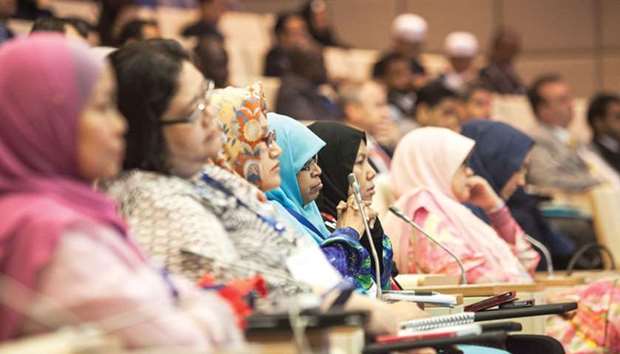The Islamic finance industry is climbing to new heights on the back of strong global demand for sustainable and socially responsible investments, the newly released fifth edition of the Islamic Finance Development Report and Indicator, or IFDI, found. The report is the result of joint research by business intelligence company Thomson Reuters and the Islamic Corp for the Development of the Private Sector, a unit of the Islamic Development Bank Group.
It states that growth in the industry is unabated despite a partial economic slowdown in a number of the industry’s main markets caused by the decrease in oil revenues over the past years.
“The data make it clear that the industry is continuing to grow and develop despite the slowdown,” says Mustafa Adil, Head of Islamic Finance at Thomson Reuters.
“It is evident that Islamic finance can serve as a strategic tool for policymakers to cope with the slowdown, especially in the Middle East. This can be seen in the many steps taken by governments and regulatory authorities such as introducing new regulations for the Islamic finance sector, raising awareness of the industry among potential market players through hosting seminars, or building a roadmap to plot development of the overall industry.”
In the view of those facts, the report estimates that the Islamic finance industry will reach a global asset volume of no less than $3.8tn by 2022, up from $2.2tn at the end of 2016, which translates into an expected compound annual growth rate of 9.5%.
“We have no doubt that the Islamic finance industry will continue to flourish over the next years,” Adil adds, highlighting key trends shaping the future of the industry such as the potential of financial technology, or fintech, as well as ongoing consolidation through mergers among Islamic financial institutions and the general growth of socially responsible investment globally.
The key measurement in the report is the Global Islamic Finance Development Indicator which provides rankings and profiles for different Islamic finance markets around the world, drawing on instrumental factors grouped into five broad areas, namely quantitative development, knowledge, governance, corporate social responsibility and awareness. The indicator does not just focus on the overall size and growth of Islamic finance sectors in different countries, it also evaluates the strength of the overall ecosystem that assists in the development of the industry.
Like in the earlier reports, the leading country as per IFDI’s methodology remains Malaysia and the leading region the Gulf Cooperation Council (GCC). Notably, countries including Tunisia, Morocco, Iraq, Russia, Spain and Poland saw strong development of their Islamic finance industries and improved their rankings.
Specifically, the leading 15 countries on the IFDI indicator are from Islamic finance’s four dominant regions, the GCC, Southeast Asia, Middle East and North African and South Asia. The top four countries – Malaysia, Bahrain, the UAE and Oman – were the same as in the two previous rankings in 2016 and 2015. Qatar has been ranked 10th in 2017, one notch down from the previous year’s ranking.
However, in terms of total Islamic finance assets (banking and non-bank investments) as per the end of 2016, Iran keeps topping the list by far with $545.3bn, followed by Saudi Arabia ($472.6bn), Malaysia ($406bn), UAE ($203.2bn) and Kuwait ($120bn). As per banking assets alone, the top four were the same with Iran with $463.5bn, Saudi Arabia with $371.2bn, Malaysia with $165.5bn and UAE with $163.1bn, but with Qatar on rank 5 with $90.8bn, ahead of Kuwait with $87.3bn.
The report constitutes a recovery for the GCC region after a slight downturn of the previous year, with the main driver being the introduction of new products and services in Islamic finance, as well as help from a partial rebound in oil prices to $55 per barrel from $30 at the beginning of 2016. This boosted the performances of several industry sectors such as Islamic banking and Islamic funds. In the region, Oman improved the most of the GCC countries. This was mainly due to the issuance of a number of sukuk and an improved regulatory infrastructure following the introduction of sukuk and takaful laws in 2016.
In Qatar, the three-way merger of Masraf Al Rayan, International Bank of Qatar and Barwa Bank, which is currently in the final phase, is expected to create the largest Islamic bank in Qatar, fundamentally changing the Industry’s landscape and rebalance Qatar’s overall financial market. The new bank will be fully run in compliance with Islamic principles and lower the number of commercial Islamic banks operating in Qatar to three, with the others being Qatar Islamic Bank and Qatar International Islamic Bank.
The report also sheds light on the possible effect that a value-added tax (VAT) might have on the Islamic finance ecosystem in the region. The planned introduction of a 5% VAT regime across the GCC is aimed at boosting government revenues following the drop in oil prices.
Saudi Arabia was first in the GCC to legislate the implementation of VAT in July 2017 and introduced it on January 1, 2018, together with the UAE. The report suggests that the tax could mean higher costs for the banking sector if fee-based services are taxed, though margin-based services such as interest on loans are likely to be exempt.
For example, in Saudi Arabia, most financial services are exempt from VAT, including Islamic finance products.
Effects on other GCC countries are too early to determine since Kuwait and Qatar have only approved draft bills for its introduction this year, while Bahrain and Oman have not announced specific legislation for VAT yet, but it is understood that they plan to also introduce it in 2018.

Delegates attend a seminar at the Global Islamic Finance Forum in Kuala Lumpur on September 3, 2014. The Islamic finance industry is estimated to reach a global asset volume of no less than $3.8tn by 2022, up from $2.2tn at the end of 2016, which translates into an expected compound annual growth rate of 9.5%.
